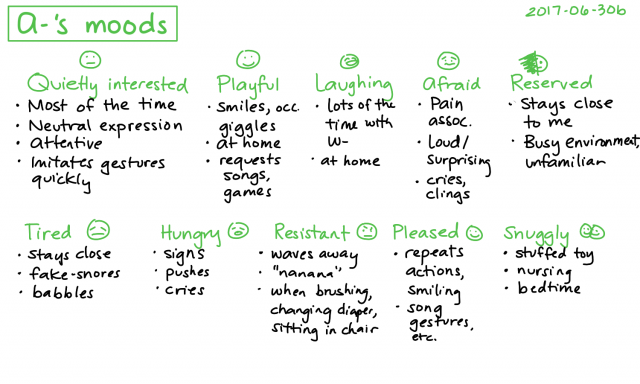A-‘s moods
| parentingI’ve been thinking about A-‘s moods: what they’re like, what influences them, and what she likes doing when. If I can match my invitations and activities to her emotional state, then I can help her regulate her emotions and make the most of learning opportunities. Here are a few moods we’ve observed.
Reserved: When we’re outside, A- usually prefers to start by watching. If the place is busy, loud, or unfamiliar, it can take her some time to warm up. I don’t push her to interact. Instead, I might model playing with things myself, or simply sit with her and soothe her until she’s ready.
Quietly interested: Once A- has warmed up, or when we’re by ourselves at home, she’s usually calmer than many of the other babies I’ve seen. Most of the time, she’s quietly interested in whatever we’re doing. She has a neutral expression, and her eyes are bright and alert.
Playful: At home, A- often initiates play by doing something (throwing a ball, etc.) and looking at us with a smile or a laugh. She likes interaction, and will happily take turns or repeat actions to keep the game going. Sometimes she’ll be playful outside too, especially if we’re in a familiar place.
Laughing: I often hear A- giggling while W- plays with her, which is wonderful. I love the way he plays with her. He’s creative and energetic, and he usually gets her laughing and learning at the same time. He’s great at trying out new things with A-. When the chores are all sorted out, I like joining them for play – partly because it’s fun, and partly because W- is an awesome parent and I want to learn more. Sometimes, if I’m extra playful and silly, I can get lots of giggles from her too.
Afraid/upset: She’s got a good memory for places and people now, which is great when we go to the early years centres and a bit more challenging when we go to the doctor, the hospital, or the ocularist. When she’s afraid or upset, she cries and clings to me, and I try my best to soothe her. I remember having a hard time focusing when we were trying to soothe her after she woke up from anaesthesia. She was four months old and crying and crying, and my brain was fuzzing out. I’ve gotten much better at staying calm and holding her while she cries, trying to soothe her by rocking, singing, nursing, and talking.
Tired/hungry: When she’s tired or hungry, she’s usually pretty good at signaling what she needs. She’ll start with eye-rubbing, yawns, fake-snores, and babbles, and then cry if I miss those signs. For hunger, she’ll sign, and then push or cry if I miss those signs.
Resistant: When she doesn’t want something to happen, she’ll frown, wave our hands away, and protest vocally. This often happens when we try to brush her teeth or put her in her high chair, and it sometimes happens when we want to change her diaper or her clothes. Sometimes waiting is enough. Sometimes it helps to offer choices. Sometimes we just need to move on.
Pleased: She smiles and seems very pleased with herself when she figures something out or does something well. She often repeats the action many times, too. For example, when she got the hang of sitting down at the right time during Ring Around the Rosies, she asked us to sing it again and again, and she sat down smiling each time.
Snuggly: At bedtime or sometimes when she nurses, she likes snuggling up close. She also likes snuggling some of her stuffed toys. She used to hug one of our cats, too, but she hasn’t done that lately.
Hmm. Maybe I don’t have to be concerned that I’m not helping A- have as much fun as she does with W-, or that I’m not playful or creative enough. =) When she’s with me, she’s usually quietly interested in stuff, punctuated by plenty of snuggles and the occasional game. She seems to be developing well thanks to the different play styles she gets exposed to (yay, W-, J-, and Y-!), so that’s cool. Onward!

